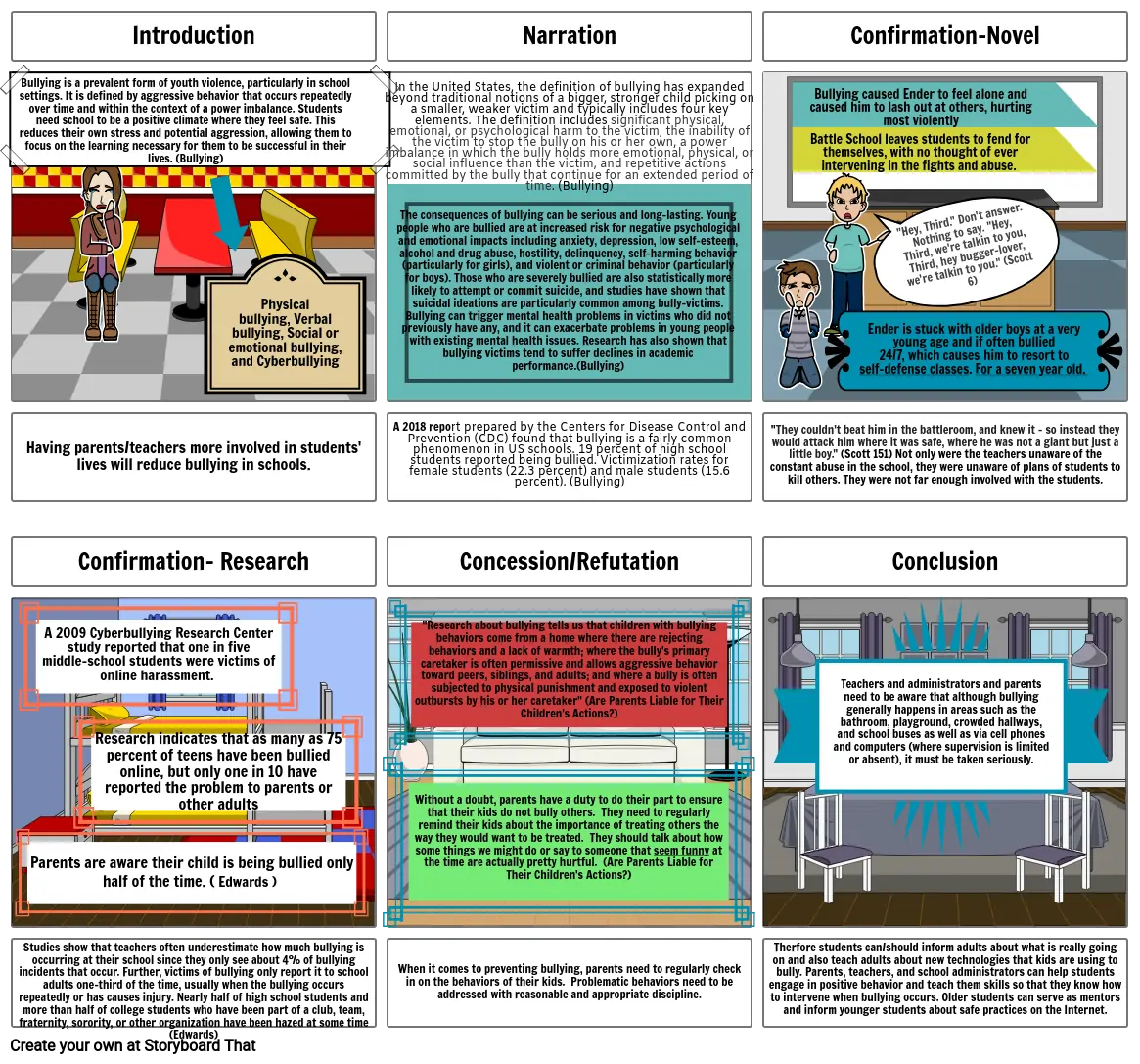Bullying & Ender's Game

Storyboard Description
Graycen Rasmussen
Ribinskas P6
Storyboard Text
- Bullying is a prevalent form of youth violence, particularly in school settings. It is defined by aggressive behavior that occurs repeatedly over time and within the context of a power imbalance. Students need school to be a positive climate where they feel safe. This reduces their own stress and potential aggression, allowing them to focus on the learning necessary for them to be successful in their lives. (Bullying)
- Introduction
- Physical bullying, Verbal bullying, Social or emotional bullying, and Cyberbullying
- In the United States, the definition of bullying has expanded beyond traditional notions of a bigger, stronger child picking on a smaller, weaker victim and typically includes four key elements. The definition includes significant physical, emotional, or psychological harm to the victim, the inability of the victim to stop the bully on his or her own, a power imbalance in which the bully holds more emotional, physical, or social influence than the victim, and repetitive actions committed by the bully that continue for an extended period of time. (Bullying)
- The consequences of bullying can be serious and long-lasting. Young people who are bullied are at increased risk for negative psychological and emotional impacts including anxiety, depression, low self-esteem, alcohol and drug abuse, hostility, delinquency, self-harming behavior (particularly for girls), and violent or criminal behavior (particularly for boys). Those who are severely bullied are also statistically more likely to attempt or commit suicide, and studies have shown that suicidal ideations are particularly common among bully-victims. Bullying can trigger mental health problems in victims who did not previously have any, and it can exacerbate problems in young people with existing mental health issues. Research has also shown that bullying victims tend to suffer declines in academic performance.(Bullying)
- Narration
- Confirmation-Novel
- Bullying caused Ender to feel alone and caused him to lash out at others, hurting most violently
- Battle School leaves students to fend for themselves, with no thought of ever intervening in the fights and abuse.
- Ender is stuck with older boys at a very young age and if often bullied 24/7, which causes him to resort to self-defense classes. For a seven year old.
- "Hey, Third." Don't answer. Nothing to say. "Hey, Third, we're talkin to you, Third, hey bugger-lover, we're talkin to you." (Scott 6)
- Having parents/teachers more involved in students' lives will reduce bullying in schools.
- Confirmation- Research
- A 2009 Cyberbullying Research Center study reported that one in five middle-school students were victims of online harassment.
- A 2018 report prepared by the Centers for Disease Control and Prevention (CDC) found that bullying is a fairly common phenomenon in US schools. 19 percent of high school students reported being bullied. Victimization rates for female students (22.3 percent) and male students (15.6 percent). (Bullying)
- Concession/Refutation
- "Research about bullying tells us that children with bullying behaviors come from a home where there are rejecting behaviors and a lack of warmth; where the bully's primary caretaker is often permissive and allows aggressive behavior toward peers, siblings, and adults; and where a bully is often subjected to physical punishment and exposed to violent outbursts by his or her caretaker" (Are Parents Liable for Their Children's Actions?)
- "They couldn't beat him in the battleroom, and knew it – so instead they would attack him where it was safe, where he was not a giant but just a little boy." (Scott 151) Not only were the teachers unaware of the constant abuse in the school, they were unaware of plans of students to kill others. They were not far enough involved with the students.
- Conclusion
- Teachers and administrators and parents need to be aware that although bullying generally happens in areas such as the bathroom, playground, crowded hallways, and school buses as well as via cell phones and computers (where supervision is limited or absent), it must be taken seriously.
- Studies show that teachers often underestimate how much bullying is occurring at their school since they only see about 4% of bullying incidents that occur. Further, victims of bullying only report it to school adults one-third of the time, usually when the bullying occurs repeatedly or has causes injury. Nearly half of high school students and more than half of college students who have been part of a club, team, fraternity, sorority, or other organization have been hazed at some time (Edwards)
- Parents are aware their child is being bullied only half of the time. ( Edwards )
- Research indicates that as many as 75 percent of teens have been bullied online, but only one in 10 have reported the problem to parents or other adults
- Without a doubt, parents have a duty to do their part to ensure that their kids do not bully others. They need to regularly remind their kids about the importance of treating others the way they would want to be treated. They should talk about how some things we might do or say to someone that seem funny at the time are actually pretty hurtful. (Are Parents Liable for Their Children's Actions?)
- When it comes to preventing bullying, parents need to regularly check in on the behaviors of their kids. Problematic behaviors need to be addressed with reasonable and appropriate discipline.
- Therfore students can/should inform adults about what is really going on and also teach adults about new technologies that kids are using to bully. Parents, teachers, and school administrators can help students engage in positive behavior and teach them skills so that they know how to intervene when bullying occurs. Older students can serve as mentors and inform younger students about safe practices on the Internet.
Over 30 Million Storyboards Created
No Downloads, No Credit Card, and No Login Needed to Try!


